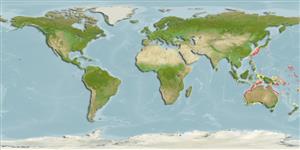Klassifizierung / Names
Namen | Synonyme | Catalog of Fishes(Gattung, Arten) | ITIS | CoL | WoRMS | Cloffa
>
Perciformes/Scorpaenoidei (Scorpionfishes) >
Triglidae (Searobins) > Pterygotriglinae
Etymology: Pterygotrigla: Greek, pterigion, diminutive of pteryx = wing, fin + Greek, trigla, es = red mullet (Ref. 45335); elicryste: Named for the senior author's grandchildren, Elizabeth, Crystal and Stephania; noun in apposition..
More on authors: Richards, Yato & Last.
Environment: milieu / climate zone / depth range / distribution range
Ökologie
seewasser benthopelagisch; tiefenbereich 124 - 138 m (Ref. 54796). Tropical
East Indian to West Pacific Ocean: Australia
Size / Gewicht / Alter
Maturity: Lm ? range ? - ? cm
Max length : 8.3 cm SL Männchen/unbestimmt; (Ref. 54796)
Kurzbeschreibung
Morphologie | Morphometrie
Wirbelzahl: 26 - 27. This species possess the following distinguishing characters: cleithral spine maybe present or absent, 7-9% SL when present, ventral to the opercular spine; sometimes with black pigment distally between spines 1-3 and 5-7 on interspinous membranes of first dorsal-fin; crenulate scales on trunk, scaled prepectoral, breast and belly; usually naked interpelvic area; outer surface of pectoral fin gray with 13 connected rays, black area on inner side of ventral 3 rays and lateral edge usually with several pale streaks; pectoral-fin length 42-51% SL, longest free ray 44-48% SL; 0-1 epibranchial gill rakers, 8-9 ceratobranchial gill rakers, length about 3% SL); 27 (rarely 26) vertebrae (Ref. 54796).
Life cycle and mating behavior
Geschlechtsreife | Fortpflanzung | Ablaichen | Eier | Fecundity | Larven
Richards, W.J., T. Yato and P.R. Last, 2003. Revision of the gurnard fish subgenus Otohime (Triglidae: Pterygotrigla). Smithiana, Bull. 2:1-18. (Ref. 54796)
IUCN Rote Liste Status (Ref. 130435)
Bedrohung für Menschen
Harmless
Nutzung durch Menschen
Mehr Information
NamenSynonymeMetabolismusRäuberÖkotoxikologieFortpflanzungGeschlechtsreifeAblaichenSpawning aggregationFecundityEierEientwicklung
Alter/GrößeWachstumLänge-GewichtLänge-LängeLängenhäufigkeitenMorphometrieMorphologieLarvenLarven Pop.Dyn.RekrutierungDichteBRUVS
ReferenzenAquakulturAquakultur ProfilZuchtlinienGenetikElectrophoresesVererbbarkeitKrankheitenVerarbeitungNutrientsMass conversion
PartnerBilderStamps, Coins Misc.LauteCiguateraGeschwindigkeitSchwimmstilKiemenoberflächeOtolithsGehirngrößeSehfähigkeit
Tools
Zusatzinformationen
Download XML
Internet Quellen
Estimates based on models
Preferred temperature (Ref.
123201): 22.1 - 23.7, mean 23 °C (based on 6 cells).
Phylogenetic diversity index (Ref.
82804): PD
50 = 0.5000 [Uniqueness, from 0.5 = low to 2.0 = high].
Bayesian length-weight: a=0.01259 (0.00515 - 0.03077), b=3.01 (2.79 - 3.23), in cm total length, based on LWR estimates for this (Sub)family-body shape (Ref.
93245).
Trophic level (Ref.
69278): 3.4 ±0.5 se; based on size and trophs of closest relatives
Fishing Vulnerability (Ref.
59153): Low vulnerability (10 of 100).
